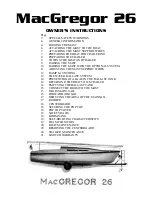
69
OPERATION
Operating in Rough Conditions
Operating the watercraft in rough
water conditions is not
recommended, and it’s illegal in
some states to operate the
watercraft in or near the surf line.
If riding in rough conditions, it’s
possible for the operator to hit
his/her chest or face on the
watercraft or handlebars and be
injured. If the operator is ejected
from the craft, injuries may make
it difficult to reboard.
Towing the Watercraft in Water
If the watercraft becomes inoperable in the water, it can be towed. Tie
about 20 feet (6 m) of tow rope to the eye located on the bow. Slowly
tow the watercraft to shore.
NOTE:
Before towing, use a pliers to close off the cooling water inlet
hose located at the bottom of the watercraft hull (hose from pump box
to exhaust pipe) to prevent hydrolock.
Riding the watercraft in rough water conditions could cause loss of
control, resulting in severe injury or death to the operator and/or
passenger. Avoid riding in rough water and/or adverse weather
conditions. Do not jump waves with the watercraft.
WARNING
Operating with excessive throttle can result in cavitation damage
to the impeller or pump. Do not operate at high throttle settings for
extended periods while the watercraft is out of the water, which
includes operation in extremely rough water.
CAUTION
Summary of Contents for 2003 Freedom
Page 1: ...2003 Owner s Safety And Maintenance Manual MODELS INCLUDE Genesis i Virage i Virage Freedom ...
Page 4: ...2 ...
Page 27: ...25 CONTROLS 1 3 6 4 7 5 2 8 10 11 9 ...
Page 29: ...27 FEATURES 7 2 5 5 1 3 2 1 5 5 4 6 7 3 6 4 Freedom Virage Models Genesis i ...
Page 33: ...31 FEATURES Genesis i Model 1 2 3 4 5 6 7 8 12 9 10 11 13 ...
Page 35: ...33 FEATURES Engine Components 12 1 3 5 6 10 7 9 8 Freedom Virage 11 2 14 15 16 13 4 ...
















































